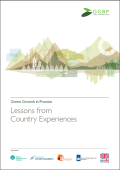
Green growth is becoming an attractive opportunity for countries around the world to achieve poverty reduction, environmental protection, resource efficiency and economic growth in an integrated way. Green growth strategies generate policies and programs that deliver these goals simultaneously. They accelerate investment in resource efficient technologies and new industries, while managing costs and risks to domestic taxpayers, businesses, communities and consumers.
This report carried out by the Green Growth Best Practice (GGBP) initiative, is the first comprehensive international assessment of lessons from experiences of pursuing green growth across all levels of government and all regions. The report is the result of a collaborative partnership between the Climate & Development Knowledge Network (CDKN), the European Climate Foundation (ECF) and the Global Green Growth Institute (GGGI). It engaged 75 authors in evaluating more than 60 programs around the world.
It is widely acknowledged that introducing a price on carbon represents a crucial precondition for filling the current gap in low-carbon investment. However, as this paper argues, carbon pricing in itself may not be sufficient. This is due to the existence of market failures in the process of creation and allocation of credit that may lead commercial banks – the most important source of external finance for firms willing to invest – not to respond as expected to price signals. Under certain economic conditions, banks would shy away from lending to low-carbon activities even in presence of a carbon price. This possibility calls for the implementation of additional policies not based on prices. In particular, the paper discusses the potential role of monetary policies and macroprudential financial regulation: modifying the incentives and constraints that banks face when deciding their lending strategy - through, for instance, a differentiation of reserve requirements according to the destination of lending - may fruitfully expand credit creation directed towards low-carbon sectors.
Part of a series of four entitled Urban Patterns for a Green Economy, this guide argues that strategic investment in physical infrastructure with the diversification of economies allows cities to play a specialised role in polycentric urban development. Furthermore, it suggests that green economic development can be achieved through the development of green clusters and green jobs. Finally, this guide argues that a number of green economy outcomes may be reached through efficiencies and shared infrastructure, rather than duplication.
The guide contains case studies from Barcelona, Newcastle, Gauteng, Delhi, Zurich, Dezhou, Randstad, and Kitakyushu.
This report aims to help environmental and other competent authorities in OECD countries to promote green business practices among small and medium-sized enterprises (SMEs). It analyses different ways to establish environmental regulatory requirements for facilities with low environmental risk (most of which are SMEs). It also examines how to design and apply information and market-based tools to promote compliance with such requirements and adoption of cleaner technologies and good environmental management practices. The report suggests several ways to increase the effectiveness of these promotion tools with respect to the SME community.
The report addresses the roles of environmental authorities, local governments, business organisations and financial institutions in the greening of small businesses. It reviews in detail the experience of France, Ireland, Korea, the Netherlands and the UK (England, Wales, and Scotland) and draws on examples of several other countries.
